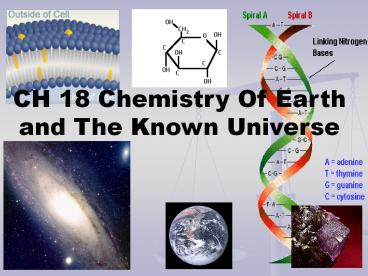Atomic Structure - PowerPoint PPT Presentation
Title:
Atomic Structure
Description:
CH 18 Chemistry Of Earth and The Known Universe Atomic Structure Subatomic Particles Proton- P+ positive charged - in nucleus Number of P+ distinguishes one atom from ... – PowerPoint PPT presentation
Number of Views:110
Avg rating:3.0/5.0
Title: Atomic Structure
1
CH 18 Chemistry Of Earth and The Known Universe
2
Atomic Structure Subatomic Particles
- Proton- P positive charged - in nucleus
- Number of P distinguishes one atom from another
- Made of 2 up quarks (2/3 charge) and 1 down
quark (-1/3 charge) - Neutron- No neutral charged - in nucleus
- Made of 2 down quarks and 1 up quark
3
Electrons
- Electron- e- negatively charged - swarming in
energy levels around nucleus of atom (electron
cloud).
Electrons (e-) are attracted to the positively
charged protons (P) in the nucleus, helping them
remain close to the nucleus in swarming levels.
4
Energy Levels
- Electrons e- have a specific amount of energy
when in each level. - K Shell has least energy
- M Shell has most energy (as far as were going)
- e- can occupy only 1 level at a time
- No matter how many levels the outer level
(valence) can have no more than 8 e- - Most stable atoms have 8 e- in valence
5
(No Transcript)
6
18.2 Comparing Atoms
- The number of P determines the type of atom.
- If you change the number of P you change the
atom.
7
18.2 Atomic Number
- The Atomic Number is total number of protons in
the nucleus of an atom.
8
18.2 Mass Number
- The total number of protons and neutrons in the
nucleus of an atom is called the Mass Number or
Atomic Mass.
9
18.2 Isotopes
- Isotopes are atoms of the same element that have
different numbers of neutrons. - Each of the below atoms are hydrogen, but they
are all isotopes of hydrogen.
10
Isotopes
- An atom can have 2 or more isotopes
- Isotopes have different numbers of neutrons
- Thus different mass numbers
- More N add mass to atom
- Heavier elements are radioactive (give off N)
11
(No Transcript)
12
18.3 The Periodic Table of Elements
- Elements are made up of only one kind of atom.
- Compounds are made up of combinations of atoms.
- Elements that are part of the same group act
alike.
13
18.3 The Periodic Table of Elements
- Dimitri Mendeleev (1834- 1907) organized
information about all the known elements in a
table that visually organized the similarities
between them. - Mendeleev placed each element on the table in a
certain row and column based on its properties.
14
- The chemical symbol is an abbreviation of the
elements scientific name.































